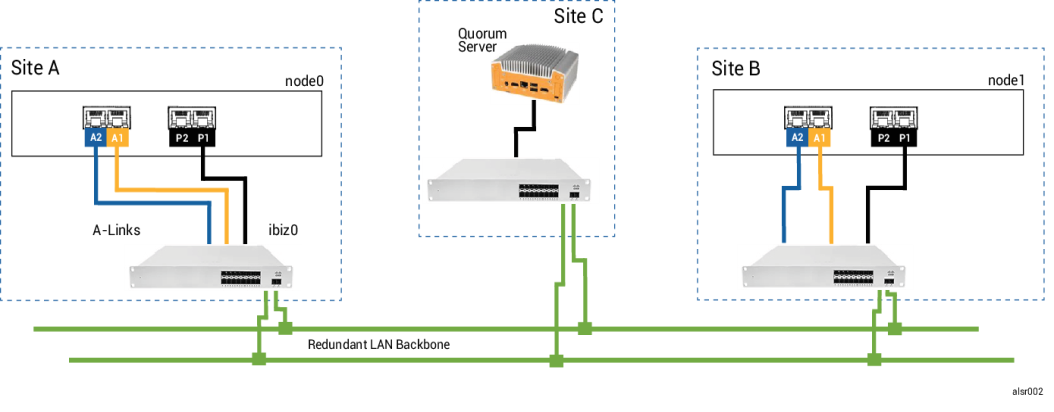Creating the Configuration
To create a SplitSite configuration, first consider the configuration of a typical everRun system configuration and the VLAN requirements of a SplitSite configuration. Then, observe a well-planned SplitSite configuration, which includes a quorum server, and become familiar with the configuration's VLAN requirements. You must also become familiar with the entire process of installing a typical everRun system and then creating a SplitSite configuration. The sections below provide this information.
A Typical everRun System
In a typical everRun system configuration, two PMs are directly connected by at least two network cables for A-Links. One A-Link typically serves as the private network (priv0). The two PMs have additional network connections for business networks, which the everRun Availability Console and guest VMs hosted by the system use. The following figure illustrates a typical configuration. (In the figures, the port labels A2, A1, P2, and P1, are an example, though most everRun systems do not have port labels.)

The physical distance between the PMs in a typical configuration is limited by the length of a single A-Link network cable, which is approximately 33 ft (10m). This distance may be significantly shorter when the physical environment and ambient electrical noise is accounted for.
A SplitSite Configuration With a Quorum Server
A well-planned SplitSite configuration consists of the two nodes at two different locations, and a third computer that runs the quorum service at a third location. All of these computers are networked together with appropriate network switching equipment, so that no single point of failure exists within the SplitSite configuration. The following figure illustrates such a configuration, which includes node0 at Site A, node1 at Site B, and the quorum server at Site C.

Notes:
- Each A-Link should be connected on its own VLAN configured between switch A and switch B.
- DNS servers and gateways are not included in the illustrations, for clarity, but you must ensure that the SplitSite configuration includes a connection to a DNS server and a gateway in the event of a network failure.
- For maximum protection, you should install redundant switches at each at site though the illustration does not show these switches. For the illustrated configuration, site A and site B would each include two switches. The A-Links are routed through one switch and the business networks are routed through the other switch. If possible, use different circuits to power the switches or use a UPS to prevent brief power loss failures.
SplitSite VLAN Requirements
The A-Link connections between switch A and switch B require a VLAN configuration on the switches. A-Link traffic is not routable, and the connection should emulate a single long network cable. Each A-Link must be isolated on its own VLAN.
If you cannot create VLANs between the switching equipment, you can use Ethernet-to-fiber media converters to create a longer fiber connection between the two PMs. However, you should not route the two A-Link fiber connections through the same physical conduit, as this creates a single point of failure.
Additionally, the quorum service computer should not share a switch with either node0 or node1 because a shared switch creates a single point of failure.
See Meeting Network Requirements for more information about the latency requirements of the A-Links and quorum connections.
From Initial Installation to Completing the SplitSite Configuration
When creating an SplitSite configuration, you should first install a typical everRun system, initially without the SplitSite configuration. For simplicity, install the nodes side-by-side. See Getting Started.
After the typical system is operating normally, create the SplitSite the configuration.
- Read Creating a SplitSite Configuration and all of its subtopics, if you have not already done so.
- Install the quorum computer and enable the quorum server. Comply with all information in:
- Verify that the quorum server has access to both nodes.
- Properly shutdown one node. See Shutting Down a Physical Machine.
-
Relocate the shutdown node to the far site.
-
Connect the infrastructure. The SplitSite-configuration illustration above shows the connections, which include:
- The priv0 connection
- The ibiz0 connection
- The second A-Link connection
-
Power on and (re-)join the nodes.
-
Verify the configuration. Ensure that:
- The shared networks pair properly—In the everRun Availability Console, navigate to the Networks page and ensure that the state of each network is green-checked. If necessary, troubleshoot any infrastructure problems.
- Quorum connections are remade—In the console, navigate to the Quorum Servers page by clicking Preferences and then Quorum Servers. Ensure that the state of the quorum server is green-checked. If necessary, troubleshoot any infrastructure problems.
- The primary node can shift from node0 to node1, and the console can connect in both configurations—Place each node in Maintenance Mode (see Maintenance Mode).
-
(Re-)join the VMs—Migrate the VMs from node to node (see Migrating a Physical Machine or Virtual Machine to a System). Verify the correct network failover of VM networking.
- Assess the status of network and validate Ethernet failover (see The Networks Page).


